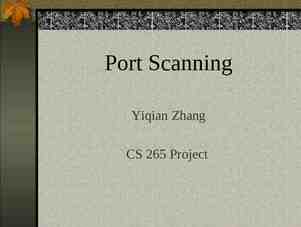System noise temperature and G/T ratio By S.Sadhish Prabhu
21 Slides116.00 KB
System noise temperature and G/T ratio By S.Sadhish Prabhu
Noise temperature It provides a way for determining how much thermal noise is generated by active and passive devices in the receiving system. Noise temperatu re Noise produced by an amplifier Thermal noise from a matched load - At same physical temperature at the input of the amplifier All objects with physical temperature , Tp greater than 0o K generate electrical noise at the receiver in microwave frequencies.
Noise power Pn k Tp Bn - (1.1) K Boltzman’s constant (1.38X10-23 J/K -228.6dBW/K/Hz) Tp Physical temperature of source in kelvin degree Bn Noise bandwidth in which the noise power is measured in hertz Pn avaliable noise power k Tp noise power spectral denisty in watts per hertz It is constant upto 300GHz
Method for designing receiving system #1 Set the BW in the receiver large to allow the signals keeiping the noise power as low as possible Equ (1.1) can be the equivalent noise band width unfortunately this cant be determined in the receiver So, 3-dB is chosen in the receiver
Method for designing receiving system #2 Keep the noise temperature low Immerse the front end amplifier in liquid helium to hold the temperature at 4 degree Kelvin Expensive and difficult to maintain Use GaAsFET amplifiers with noise temperature of 70K at 4 GHz and 180 K at 11 GHz without cooling
Performance of the receiving system Find the thermal noise against which the signal must be demodulated To do this system noise temperature must be found out , Ts Ts - noise temperature of a source , located at the input of a noise less receiver, which gives the same noise power as the original receiver, measure at the output of the receiver
Noise power Noise power at the input of demodulator is, Pno k Ts Bn Grx watts - (1.2) Where Grx gain of the receiver from RF input to the demodulator input
Problem 1 An antenna has noise temperature of 35 K and is matched into a receiver which has a noise temperature of 100 K calculate: a) noise power density and b) the noise power for a bandwidth of 36 MHz.
Solution a) NO k TN 11.38 x 10-23x (35 100) 1.86 x 10-21 J b) PN NO BN 1.86 x 10-21x 36 x 106 0.067 pW
Carrier-to-noise ratio Let the antenna deliver a power Pr to the receiver RF input The signal power at the demodulator input is Pr Grx watts Carrier –to-noise ratio at the demodulator is, C P r G rx Pr N kT s B n G rx kT s B n
Calculation of system noise temperature Antenna LNA BPF Mixer BPF IF amp IF output Pr Grf Gm Local oscillator Single Super heterodyne receiver GIF
Noise model of receiver Tin Gain Grf Gain Gif Pn Noiseless RF Amplifier Trf Gain Gm Noiseless mixer Tm Noiseless IF Amplifier Tif a) The Noisy amplifier and down converters are replaced by noise less units with equivalent noise generators at their inputs
Noise model of receiver Tin Gain Grf.Gm.Gif Noiseless Rreceiver Ts b) All noisy unit replaced with one noiseless amplifier with a single noise source Ts Pn Tin Gain Gl Pn Noiseless lossy device Tno c) The lossy device is replaced with lossless device , with a signal noise source Tno
Noise power Total noise power : Pn GIF k TIF Bn GIFGmkTmBn GIFGmGRFkBn(TRF Tin ) Pn GIFGmGRF [(k TIF Bn )/GRFGm ( kTmBn)/GRF (TRF Tin) ] GIFGmGRF k Bn [TRF Tin Tm /GRF TIF /(GRFGm ) ] Here Ts generates the same noise power Pn at its output if Pn GIFGmGRF k Ts Bn Noise power in the noise model (b) will be equal to (a) if k Ts Bn k Bn [TRF Tin Tm /GRF TIF /(GRFGm ) ] Hence, Ts [TRF Tin Tm /GRF TIF /(GRFGm ) ] Conclusion: The receiver gives less noise as the gain from each stage is added hence the noise contributed by the IF amplifier and later sages can be ignored
Calculation of system noise temperature LNA BPF First IF amplifier BPF Mixer First L.O. 900 to 1400 MHz D BPF Mixer Second L.O. BPF Second Demodulator Baseband out put IF amplifier Double Super heterodyne receiver
G/T ratio for earth station The link equation can be rewritten as : C P tG tG r N kT s B 4 R 2 2 C P tG t G r N kB 4 R T s Constants Figure of merit Gives the quality of an earth station
Antenna Noise Temperature Noise Temperature of an Antenna as a Function of Elevation Angle:
Problem 2 Suppose we have a 4 GHz receiver with the following gains and noise temperature Tin 50 K Trf 50 K Tin 500 K Tif 1000 K Grf 23 dB Gm 0 dB Gif 30 db Calculate the system noise temperature.
Solution Ts 152.5 K
Problem 3 An earth station antenna has a diameter of 30 m , has an overall efficiency of 68% , and is used to receive a signal at 4150 MHz. At this frequency , the system noise temperature is 79 K when the antenna points at the satellite at an elevation angle of 28 degree. What is the earth station G/T under these conditions? If heavy rain causes the sky temperature to increase so that the system noise temperature rises to 88 K , what is the new G/T value
Solution G/T 41.6 dBK-1 If heavy rain G/T 41.2 dBK-1


























